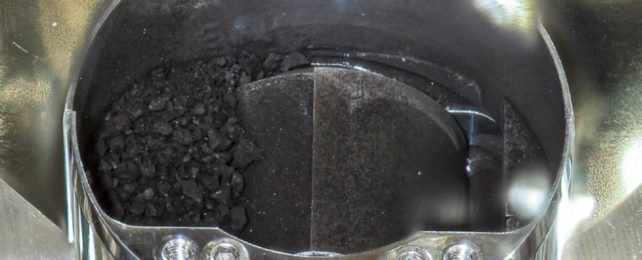Rubble retrieved from an asteroid in near-Earth solar orbit could be the most 'pristine' sample of cosmic rock we've had our primate paws on yet.
According to a new, in-depth analysis of the material delivered to Earth from the asteroid Ryugu, the samples of rocks and dust are among the most uncontaminated Solar System materials we've ever had the opportunity to study – and their composition suggests that they incorporate chemistry from the outer reaches of the system.
This not only gives us a unique tool for understanding the Solar System and its formation, it gives us new context in which to interpret other space rocks that have been contaminated by coming into contact with Earth.
"Ryugu particles," wrote a team led by cosmochemist Motoo Ito of the Japan Agency for Marine-Earth Science Technology (JAMSTEC) in Japan, "are the most uncontaminated and unfractionated extraterrestrial materials studied so far, and provide the best available match to the bulk Solar System composition."
It has been around 4.6 billion years since the Sun formed, and the Solar System around it. Obviously that's a very long time, and a lot of things have changed since then; but we do have time capsules that allow us to study the chemistry of the early Solar System in order to understand how it all came together. These are chunks of rock, such as comets and asteroids, that have been drifting about in space more or less unchanged since they formed.
Visiting a rock far from Earth isn't easy, and collecting and returning samples even less so. Historically, we've relied on space rocks coming to us to get our mitts on these time capsules. Meteorites known as carbonaceous chondrites have been the best tool available to probe the composition of the asteroids that may have delivered water to Earth, as the Solar System was still forming.
However, this record is biased by a kind of mineral version of survival of the fittest. Only the strongest chunks of space rock persist through the explosive rigors of atmospheric entry, and even then they become altered and contaminated by the terrestrial environment.
In recent years, venturing out to touch down on asteroids has fallen within our capabilities. In December of 2020, a probe that had been sent to Ryugu by the Japanese Space Agency (JAXA) dropped off an invaluable payload: samples of material collected from the surface of the asteroid, and transported home in sterile containers.
Scientists have been avidly studying the contents ever since, revealing that the asteroid is compositionally very similar to those carbonaceous chondrites, making it what we call a C-type asteroid. It also contains prebiotic molecules – the precursors to biological compounds – and may have once been a comet.
The new analysis delves even deeper. Ito and his colleagues have found that the abundances of heavy hydrogen and nitrogen in the asteroid are consistent with an origin in the outer Solar System; that is, Ryugu started its life much farther from the Sun. This would be consistent with the comet theory, since those icy bodies are visitors from the Solar System's farther reaches.
Ryugu, the researchers found, also has one glaring difference from carbonaceous chondrites. Missing from the asteroid samples are ferrihydrite (compounds of iron and oxygen) and sulfate (sulfur and oxygen). Since these compounds are found in meteorites, they were thought to be a component of extraterrestrial materials. The lack of them in Ryugu suggests that they could be the result of terrestrial weathering in the meteorites.
This means that future meteorite studies should make allowances for this possibility… and that future asteroid sample return missions will be able to shed more light on the matter.
"In this study we demonstrate that [carbonaceous] meteorites, despite their geochemical importance as proxies of the bulk Solar System composition, are terrestrially contaminated samples," the researchers wrote in their paper.
"The findings of this study clearly demonstrate the importance of direct sampling of primitive asteroids and the need to transport returned samples in totally inert and sterile conditions. The evidence presented here shows that Ryugu particles are undoubtedly among the most uncontaminated Solar System materials available for laboratory study and ongoing investigations of these precious samples will certainly expand our understanding of early Solar System processes."
The research has been published in Nature Astronomy.
